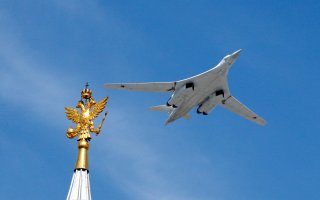Russia's Tu-160's Bomber Is Back and More Killer Than Ever
Russia is currently working to modernize its existing fleet of Tu-160s with improved engines and avionics.
Here's What You Need To Remember: According to the Jamestown Foundation, “The production of a modernized Tu-160 strategic bomber will require close cooperation among several different plants and the organization of a whole production chain—something that has been a weak point in Russia.”
Fastest bomber ever built. The largest bomber ever built. Heaviest bomber ever built. All of these monikers refer to the Tupelov Tu-160 “White Swan” (NATO reporting name “Blackjack”), a legacy Soviet airframe that has of late gotten a new lease on life.
Swan Diving Towards the Enemy
The Tu-160 is outwardly somewhat similar to the American Rockwell B-1 Lancer which spurred its development. Both have variable-sweep wings, both are supersonic. However, that is where the similarities end.
The B-1 Lancer is somewhat smaller, and is a bomber in the classic sense. The Tu-160, on the other hand, is used more as a stand-off weapons platform, in which missiles are launched from the bomb bay doors while the “White Swan” would speed off at Mach 2+ to safety. It is the only Soviet-designed bomber that does not carry any defensive weapons, although its prodigious 88,000 pounds of payload capacity can carry a dizzying array of conventional and/or nuclear weapons.
Why the nickname “White Swan” you ask? Because the entire plane is coated in a brilliantly white reflective coating. It’s protection for the crew. The Tu-160 can carry a nuclear payload, which, obviously, creates a massively bright fireball. The thermal energy of nuclear explosions is enormous, and by reflecting some of that thermal energy (light), the crew is at least in theory somewhat more protected than otherwise.
Variable sweep wings are no longer in vogue, but offer some advantages. (Check out this F-14 Tomcat for a prime example of variably-swept wings!) During low-speed flight, like landing or takeoff, a straight wing offers more lift. At higher speeds, especially in the supersonic range, a straight wing causes unnecessary drag, and a steeply swept wing would be more efficient. Hence the variable-sweep capability of the Tu-160, with “unfolds” its wings at lower speeds, and “folds” them when flying supersonic.
A New Lease on Life
Although there is no serious design flaw inherent to the Tu-160 design, one of the serious drawbacks is the fact that it is not stealthy.
But stealth is hard. And expensive. Russia’s only stealth aircraft, the Su-57 has had myriad teething problems and is unlikely to enter full serial production any time soon due to many issues — the low cost of oil, upon which the wobbly Russian defense budget depends, and engine issues that may be difficult to rectify any time soon.
What to do when a new design isn’t working out as hope? Fall back on what’s tried and true, with an update. Russia is currently working to modernize its existing fleet of Tu-160s with improved engines and avionics.
The Jamestown Foundation, a research and analysis think tank elaborated on the upgrade: “The production of a modernized Tu-160 strategic bomber will require close cooperation among several different plants and the organization of a whole production chain—something that has been a weak point in Russia.”
It may be some time before we see any new bombers flying around in Russia, stealthy or otherwise.
Caleb Larson is a Defense Writer with The National Interest. He holds a Master of Public Policy and covers U.S. and Russian security, European defense issues, and German politics and culture.
This article first appeared last year and is being reprinted due to reader interest.


